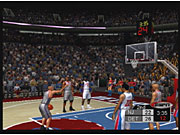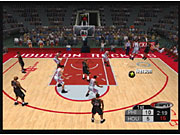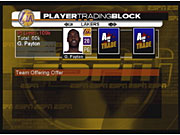ESPN NBA Basketball is the continuation of the NBA 2K series of basketball games, a franchise which was born on the now-defunct Sega Dreamcast. Despite the series' relative youth, compared to other basketball franchises, the 2K series has always been known for fantastic graphics and excellent simulation-style gameplay. This year, the developers at Visual Concepts have kept all the hallmarks of their earlier games, and they've added a new control system called "isomotion." This system lets you execute juke moves on offense, and it gives you the ability to counter these jukes on defense. The team has also added a unique gameplay mode called 24/7 that is so addictive, it's likely that many players will spend more time in 24/7 than playing standard games. If you are planning on buying only one basketball game this year, ESPN NBA Basketball is the one to get.

Along with the series' name change comes an even deeper integration and infusion of the ESPN brand throughout the game. Menu screens reflect a thoughtful degree of polish; in fact, the opening menu gives you a view of the ESPN studio. Most of the text in the game uses the same fonts you see on ESPN broadcasts, and all the familiar music from NBA-related shows are included. Even the loading screens before you enter each match include pregame commentary from ESPN newscaster Kevin Frazier.
As any fan of the series might expect, ESPN NBA Basketball features excellent graphics, particularly on the player models. The newly modeled faces on players and coaches are extremely detailed--detailed to the point that the vast majority should be instantly recognizable to an NBA fan even without the benefit of seeing a jersey. The player models and lines on the court do look a bit cleaner on the Xbox, however, as it exhibits less blurriness on the edges. The difference in graphics between the two systems is most apparent when you're given a close-up view of a player with tattoos. On the Xbox version of the game, Shaq's "Against The Law" shoulder tattoo is crisp and easily readable, whereas the same texture on the PlayStation 2 is considerably blurrier and more difficult to read. In the grand scheme of things, the differences are not overwhelming, but they're noteworthy nonetheless.
The game's animations are equally worthy of praise. Whether performing a killer crossover, flushing down a dunk, or ripping a rebound down off the glass, the players in ESPN NBA look very fluid in their motions. You'll see the crowd stand up and wave their arms or clap thundersticks behind the basket when an opposing player takes a free throw. The developers have even included the free-throw idiosyncrasies of a few star players for when they line up at the charity stripe. You'll see Jason Kidd blow his signature kiss to his son before shooting, and Karl Malone will flip the ball in his hands (without whispering to himself for a few seconds as he does in real life).
In the sound department, ESPN NBA features commentary by broadcasters Bill Fitzgerald and Tom Tolbert. While they do a decent job, overall, the commentary does get repetitive fairly quickly. Tolbert is often prone to saying silly things like, "if the coach had a white flag, he'd probably throw it onto the court now," in response to a blowout situation. Thankfully, the game includes several options for in-game sound, including a couple (in the stands and on court) that omit the commentary entirely. Once that's removed, the focus is placed much more on sneakers squeaking on the waxed floors, chatter between players and coaches, stadium organs, and crowd noise. The game also includes a few hip-hop music tracks that figure in more prominently during menu screens and in the other gameplay modes. Though no marquee artists are included, the tracks are still pretty good, leaving you liable to bob your head a bit as you play through the street modes.

The big, new addition to the gameplay this year is isomotion, which is basically ESPN NBA's answer to NBA Live's freestyle system. There are some notable differences in implementation, however. On offense, isomotion feels a little less involved than freestyle. Tapping in a direction with the right control stick unleashes an animation that's pretty much canned. For example, you can't dictate how many times you're going to cross the ball over, back and forth, before you start your drive. You can cancel out of a move by tapping back, which will draw your player back with a hesitation dribble. So, if you can tell your first move isn't going to work, you can try again.
Each isomotion move you execute reduces a substantial portion of your fatigue meter, so you can't just sit there with one player for the duration of the shot clock trying juke after juke to get past your man. You'll get two--maybe three--cracks at it before you have to pass the ball to a teammate with more energy. Don't expect to perform crazy maneuvers with a big man either. The guards, with better ballhandling skills in real life, are generally the ones who benefit the most from these jukes and, subsequently, have better moves in the game. Centers and power forwards are quite likely to turn the ball over executing an isomotion. Also, if you're careless with the moves you try, it's very easy to knock your opponent down and get whistled for charging. These limitations help the game keep its simulation feel, but experienced players will eventually learn to pull off some complex, street-style maneuvers to free themselves up.

Isomotion differs from freestyle on defense as well. Instead of just reaching for a steal, as in NBA Live, the isomotion system works to counter the moves your opponent is making on offense. It basically comes down to a reflex game where you watch the ballhandler's animation and try to time your own move to match it. If you're successful, the defender you're controlling will hop into the driving lane of the ballhandler, causing a collision that will result in a charge or an abrupt stop by the offensive player. If you guess it totally wrong, you can expect to have your ankles broken as the offensive player blows by you.
Outside of isomotion, ESPN NBA retains the signature simulation feel that it's refined over the years. To be successful on offense, you're going to have to work the ball around the half-court, using screens and sharp passes to find an open shot. You'll often feel good just putting down a simple midrange jumper, knowing that your patience and ball movement helped create that open look. Passing out of the double-team to the open man is key, and you'll quickly learn to make the extra pass, off the break, to get the best possible shot. You'll still be able to fast-break once in a while, but the key to getting these opportunities, as in real life, is to clean up the defensive glass and pick your spots. Fatigue also plays a role in the game, although it doesn't come too much into play at the default five-minute quarters. Lengthier games require you to dip deeply into your bench to give starters a breather. The game also includes a biorhythm indicator that tells you who's hot and who's cold.
On defense, you'll need to be equally deliberate, as the computer is very unforgiving--even at the default difficulty level. Don't try to run up to your man and pound on the steal button, as in other games. At the default settings, you'll get hit with a reach-in call if you don't pick a good opportunity to try for a rip. The AI is generally very good about finding the open man, if you like to double-team. You'll frequently see the player you just left streaking toward the basket for an easy layup if you aren't judicious about bringing the trap. The computer is also relentless about crashing the offensive boards, so if you aren't careful about getting good position and timing your jumps, you can expect to give up a ton of second chance points. At first, playing defense can seem kind of frustrating, as your teammate AI sometimes seems very inept at pulling down rebounds and rotating defensively. Once you get used to micromanaging your defenders, though, you'll find that getting defensive stops isn't impossible and is very rewarding.

There are a couple of nitpicky flaws with the gameplay though. One is that it seems odd that a simulation game wouldn't include a customizable offensive playbook. There are just four basic plays, including isolation and low post. You would think that a simulation-style game would include tons of motion sets, staggers, triangles, and the high post, but these options don't seem to be in the game. On defense you have a greater set of choices. You can execute the full-court press, half-court traps, plain man-to-man coverage, a variety of zone defenses, including 2-3, 3-2, and 1-3-1 setups, and/or the box-and-1. Another odd thing is that blocked shots in ESPN NBA tend to sail out of bounds. While nasty swats are certainly a part of the NBA, at the default settings they seem to happen with alarming frequency, both for you and by the computer. Thankfully, the game includes options to turn down the blocks as well as to adjust almost any other aspect of gameplay that you could possibly think of.
ESPN NBA features a ton of different modes, adding great value to the game. These include full-court and half-court games for two to five players per team, a one-on-one mode, and a game of 21 for three or four players. The hardcore simulation rules are relaxed greatly in street mode, so you can feel a lot freer with the isomotion maneuvers. Street mode settings include a few real-life courts, like Rucker Park, as well as other places, like at the base of the Golden Gate Bridge in San Francisco or at Venice Beach in Los Angeles. A plain suburban driveway and an alley behind a fish market round out the available street courts. As far as street mode teams go, the game makes it easy for you to mix and match all-time greats, like Magic Johnson and Wilt Chamberlain, with today's stars.

ESPN NBA's franchise mode offers a great level of depth and polish. It includes all the basics you'd expect, like full-length seasons, fantasy drafts, trades, and a point cap for all teams. It truly goes the extra mile with other features. Not only do you have to worry about players and point caps, but you have to hire a full staff, including coaches, a trainer, and a scout. You're also able to dictate the play style of your team when you simulate games. Do they try to crash the boards, or do they try to fast-break? Should they try to score inside or shoot from outside? Which positions are the primary and secondary scoring options? The front office interface also includes a trading block feature that lets you inform other teams that you're interested in trading a specific player or players from your team. Run the simulation for a couple of weeks, and when you return to the trading block, you'll find trade offers on the table from a few other teams.
The draft process is particularly well-designed in ESPN NBA. Prior to the draft, you're able to spend time looking over all of the eligible prospects. If you have a highly skilled scout, you'll know almost everything you need to know about all the players right off the bat. Leave yourself with a bad scout, and you'll know very little about each player. As a result, you'll have to spend money and time bringing in prospects for workouts to learn more about them. Once you enter the draft, armed with your notes, the game takes you to a simulated draft auditorium. When your turn comes, you're actually "put on the clock," or given a time limit to make your selection.
As if the street modes and franchise modes weren't enough, ESPN NBA piles on the value with its unique 24/7 mode. In this gameplay mode, you'll create a player, customizing his height and appearance from a variety of options, including faces, skin tone, hair styles, and accessories, like tattoos, knee braces, and Allen Iverson-style arm sleeves. Once that's done, you start out in the world as an aspiring baller with very few skills. You can go to the training gym where you'll compete against low-level NBA players in a game of one-on-one. Depending on which skill you feel like trying to improve, you'll be asked to meet some challenge criteria during the match to improve your player's attributes. For example, if you want to enhance your dunking ability, you'll need to carry out a certain number of dunks or layups in a row without getting your shot blocked.
Once you've achieved a basic skill level, you can then travel to different parts of the country to participate in various challenges. Strangely similar to Animal Crossing, 24/7 mode is tied to your console's system clock. If you ignore your character for a couple of days, some of your earned attributes will actually decay. The games and opponents available to you also differ, depending on the time of day. If you play at 3pm in Maine, you may be able to participate in a three-pointers-only match against Mike Dunleavy, Jr., while at 11am in Seattle you might be able to participate in a dunks-only game against a different player. Once you defeat a player in these challenges, you earn ranking points, a special bit of clothing or accessory from the player, and that player's cell phone number. In certain gameplay modes, you'll need a teammate or two, so these cell phone numbers come in handy for calling up a new friend. As you go through 24/7 you can take on boss characters, unlock new areas, and customize your character with all the new loot you earn. All of this makes 24/7 mode extremely fun and addictive. The fact that you can take your character online and play makes it even better.
ESPN NBA Basketball also has full support for online games via Xbox Live. The games we played were very smooth and suffered from far less slowdown and latency than we experienced on our first day with the PS2 version online. However, some fundamental problems still plague the Xbox version of the game. Like the PS2 version, online opponents must share the same camera angle, which is very annoying, and it's possible for one player to change game settings on the fly. The leaderboards also seem very slow to update at this point, and unlike the PS2 version, there are no online lobbies for players to congregate and chat. While it's a great addition, online multiplayer is clearly not ESPN NBA's strong suit at this point in time. If you're interested in the game primarily for its online component, you may wish to give it a rent before committing to a purchase.

While there are a small handful of faults with the game, ESPN NBA Basketball has just about everything a hardcore NBA fan could ask for. It includes a tough, but rewarding, simulation-style of gameplay, a feature-packed franchise mode, street-style game modes, and the truly unique 24/7 gameplay mode that might be good enough to be its own game. If you're a hardcore NBA fan with an Xbox or PlayStation 2, your game library just isn't complete without a copy of ESPN NBA Basketball.